1996 CHEVROLET MONTE CARLO heater
[x] Cancel search: heaterPage 70 of 340
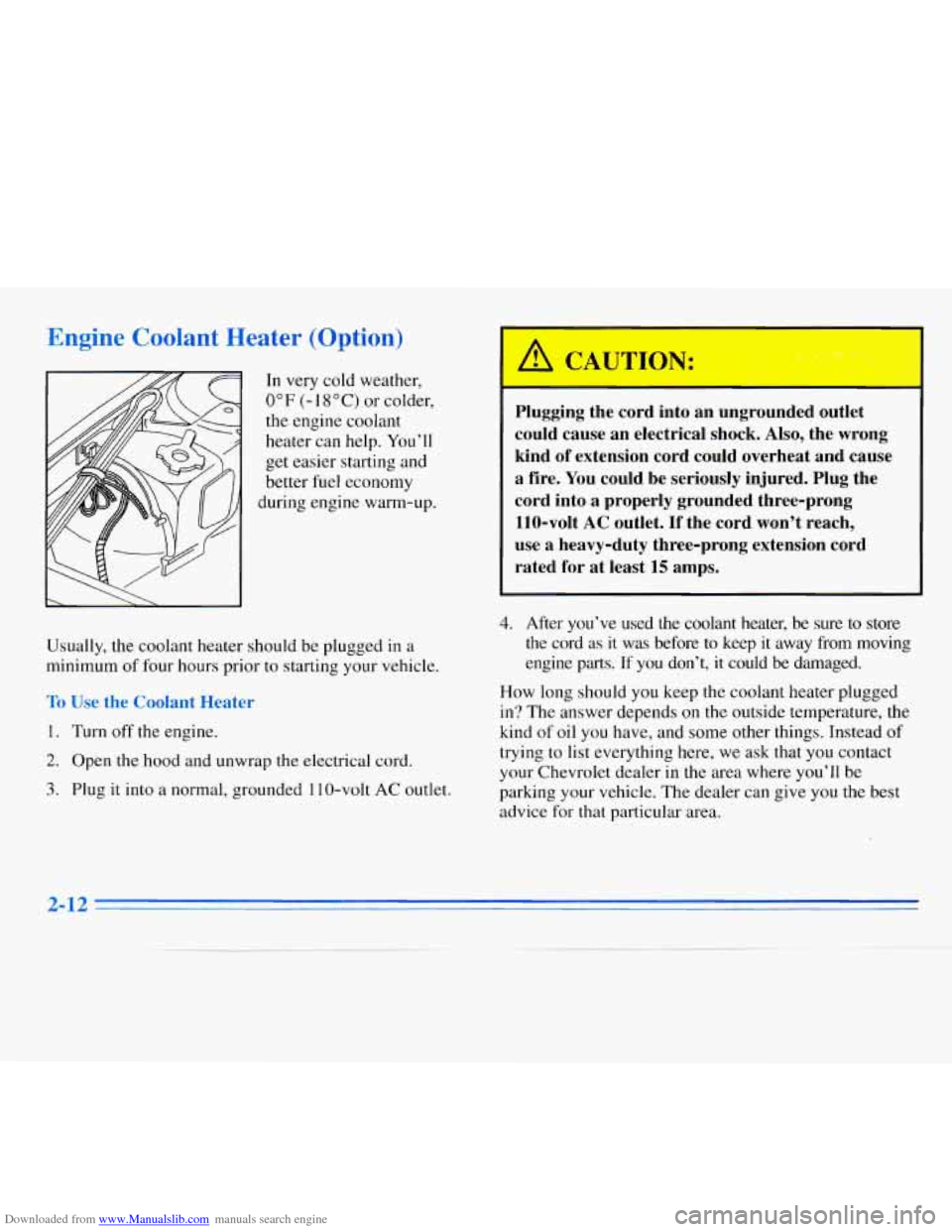
Downloaded from www.Manualslib.com manuals search engine Engine Coolant Heater (Option)
In very cold weather,
0°F (- 1 S’C) or colder,
the engine coolant
heater can help. You’ll
get easier starting and
better
fuel economy
during engine warm-up.
Usually, the coolant heater should be plugged in a
minimum of four hours prior to starting your vehicle.
To Use the Coolant Heater
1. Turn off the engine.
2. Open the hood and unwrap the electrical cord.
3. Plug it into a normal, grounded 1 10-volt AC outlet.
’ .A CAUTION:
1 - - -+* ,
Plugging the cord into an ungrounded outlet
could cause an electrical shock.
Also, the wrong
kind of extension cord could overheat and cause
a fire. You could be seriously injured. Plug the
cord into a properly grounded three-prong
110-volt
AC outlet. If the cord won’t reach,
use a heavy-duty three-prong extension cord
rated for
at least 15 amps.
4.
After you’ve used the coolant heater, be sure to store
the cord
as it was before to keep it away from moving
engine parts. If you don’t, it could be damaged.
How long should you keep the coolant heater plugged
in? The answer depends on the outside temperature, the
kind of oil you have, and some other things. Instead of
trying to
list everything here, we ask that you contact
your Chevrolet dealer in
the area where you’ll be
parking your vehicle. The dealer can give you the best
advice for that particular area.
2-12
Page 90 of 340

Downloaded from www.Manualslib.com manuals search engine Sustained Interior Illumination
Your courtesy lamps will come on and stay on for a set
time whenever you:
Open a door.
Press UNLOCK on the Remote Lock Control
transmitter (if equipped).
0 Press DOOR on the Remote Lock Control
transmitter (if equipped).
If you open
a door, the lamps will stay on while it’s open
and
then turn off automatically about 18 seconds after
you close it. If you don’t open
a door, the lamps will
turn off after about 18 seconds, unless you pressed
UNLOCK on the Remote Lock Control transmitter. If
you pressed UNLOCK and don’t open a door, the lamps
will turn off after about
55 seconds.
Sustained interior illumination includes a feature called
theater dimming. With theater dimming,
the lamps don’t
just turn off at the end
of the delay time. Instead, they
slowly dim during the delay time until they go out. The
delay time
is cancelled if you turn the ignition key to
RUN or START, so the lamps will go out right away.
When the ignition is on, sustained interior illumination
is inactive, which means the courtesy lamps won’t
come on.
Rearview Mirror Reading Lamps
These lamps go on when you open the doors. When the doors
are closed,
turn the lamps on and off with the switches.
Battery Saver
Your vehicle has a feature to help prevent you fiom draining
the battery,
in case you accidentally leave the courtesy lamps
on. If you leave the dial turned all the way up, or if you leav\
e
a door open, the lamps will automatically turn
off after
10 minutes if the ignition is off.
This feature will not turn off the reading lamps, only the
lamps controlled by the dial. Be sure to turn
off any reading
lamps using the switch before you leave the vehicle.
2-32
Page 115 of 340
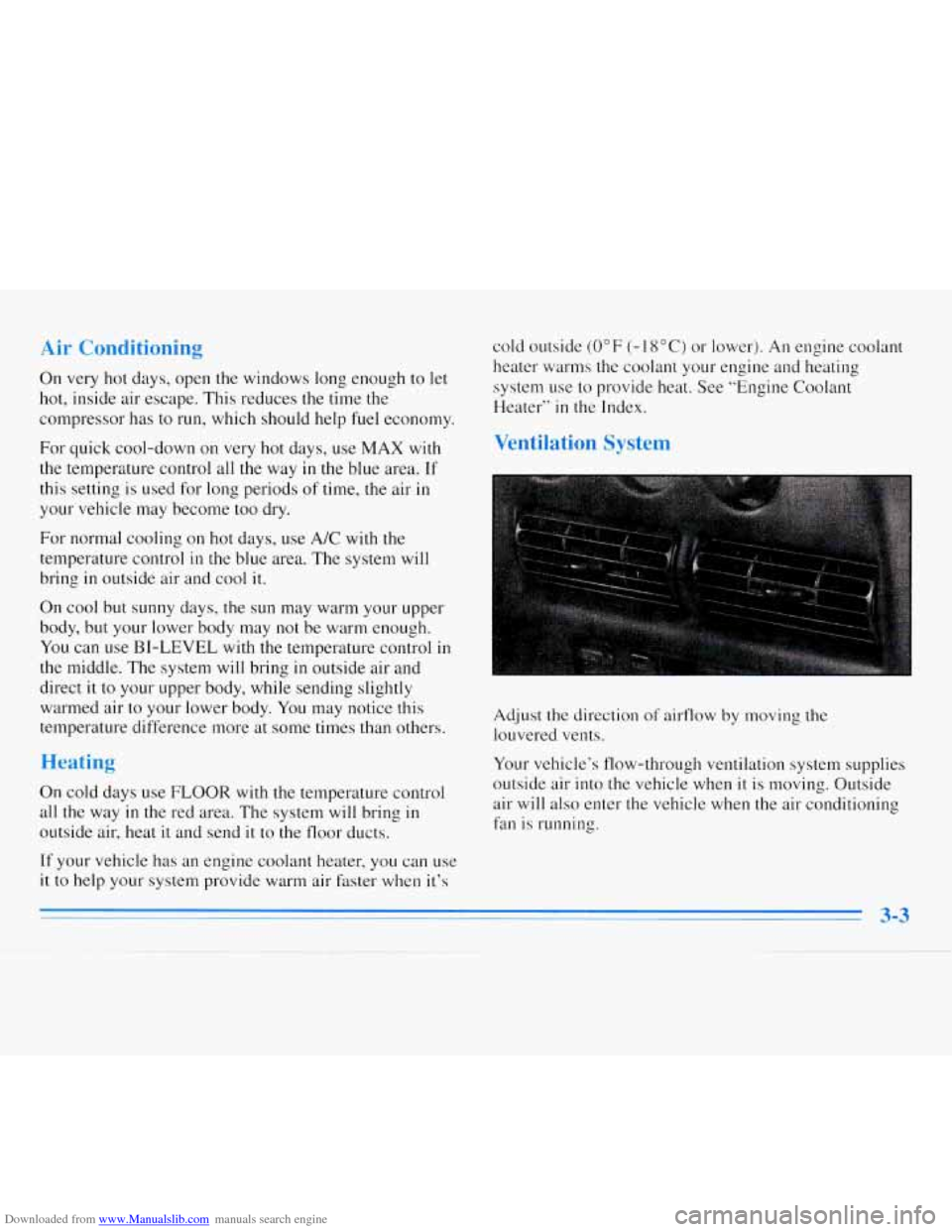
Downloaded from www.Manualslib.com manuals search engine Air Conditioning
On very hot days, open the windows long enough to let
hot, inside air escape. This reduces
the time the
compressor has to
run, which should help fuel economy.
For quick cool-down on very hot days, use
MAX with
the temperature control all
the way in the blue area. If
this setting is used for long periods of time, the air in
your vehicle may become too dry.
For normal cooling on hot days, use A/C with
the
temperature control in the blue area. The system will
bring in outside air and cool
it.
On cool but sunny days, the sun may warm your upper
body, but your lower body may
not be warm enough.
You can use BI-LEVEL with the temperature control in
the middle. The system will bring in outside air and
direct
it to your upper body, while sending slightly
warmed air to your lower body.
You may notice this
temperature difference more at some times than others.
Heating
On cold days use FLOOR with the temperature control
all the way in the red area. The system will bring in
outside air, heat it and send it to the floor ducts. cold
outside
(0°F (-18°C) or lower). An engine coolant
heater warms the coolant your engine and heating
system use to provide heat. See “Engine Coolant
Heater”
in the Index.
Ventilation System
Adjust the direction of airflow by moving the
louvered vents.
Your vehicle’s flow-through ventilation system supplies
outside air into the vehicle when
it is moving. Outside
air
will also enter the vehicle when the air conditioning
fan is running.
If your vehicle has an engine coolant heater, you can use
it to help your system provide warm air faster when it’s
3-3
Page 116 of 340
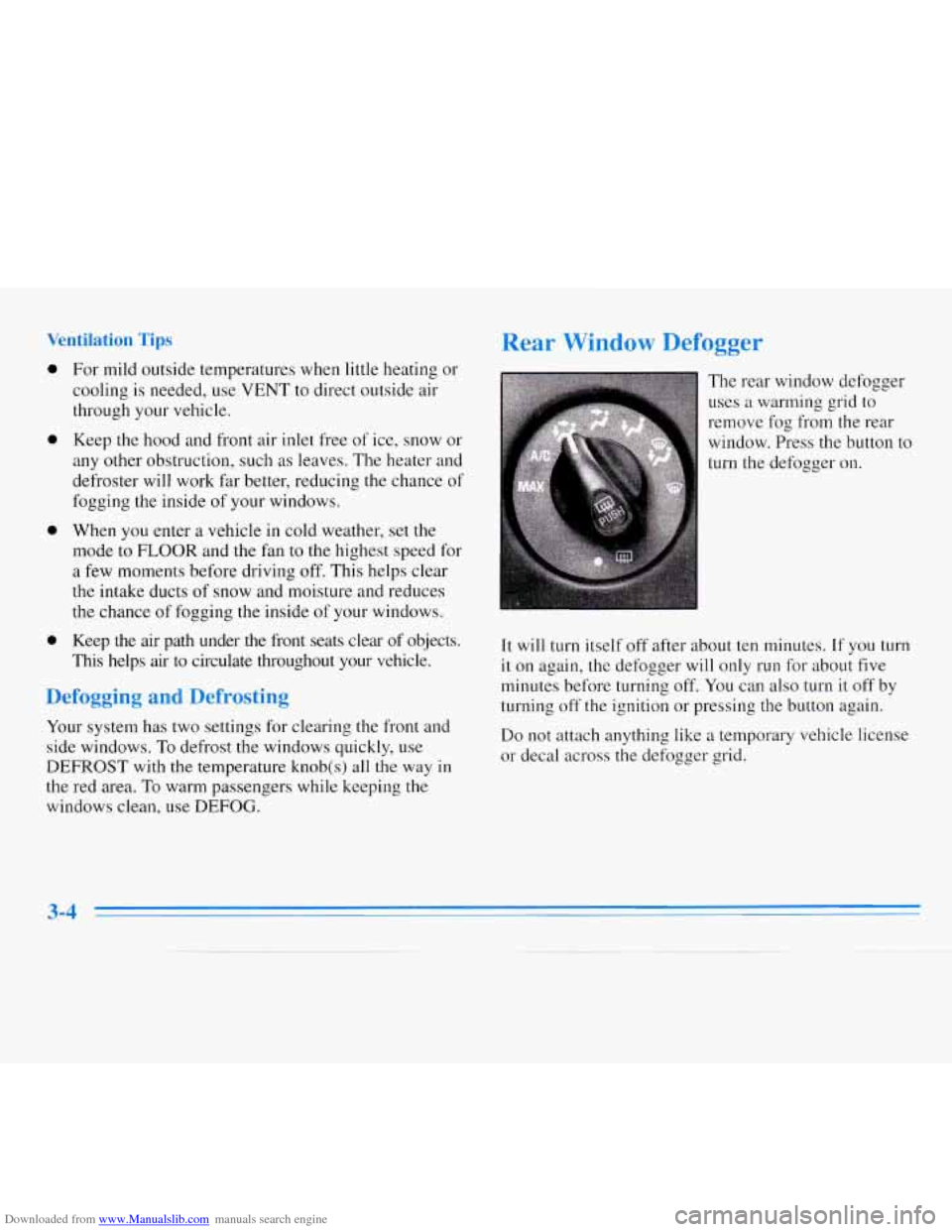
Downloaded from www.Manualslib.com manuals search engine 0
0
0
0
ilation Ti-
For mild outside temperatures when little heating or
cooling is needed, use
VENT to direct outside air
through your vehicle.
Keep the hood and front air inlet free of ice, snow or
any other obstruction, such
as leaves. The heater and
defroster will work far better, reducing the chance of
fogging the inside of your windows.
When you enter
a vehicle in cold weather, set the
mode to FLOOR and the fan to the highest speed for
a few moments before driving off. This helps clear
the intake ducts of snow and moisture and reduces
the chance of fogging the inside
of your windows.
Keep the air path under the front seats clear of objects.
This helps
air to circulate throughout your vehicle.
Defogging and Defrosting
Your system has two settings for clearing the front and
side windows.
To defrost the windows quickly, use
DEFROST with
the temperature knob(s) all the way in
the red area. To warm passengers while keeping the
windows clean, use DEFOG.
Rear Window Defogger
The rear window defogger
uses a warming grid to
remove fog
from the rear
window. Press the button to
turn the defogger on.
I
It will turn itself off after about ten minutes. If you turn
it on again, the defogger will only run for about five
minutes before turning off. You can also turn
it off by
turning
off the ignition or pressing the button again.
Do not attach anything like a temporary vehicle license
or decal across the defogger grid.
3-4
Page 162 of 340
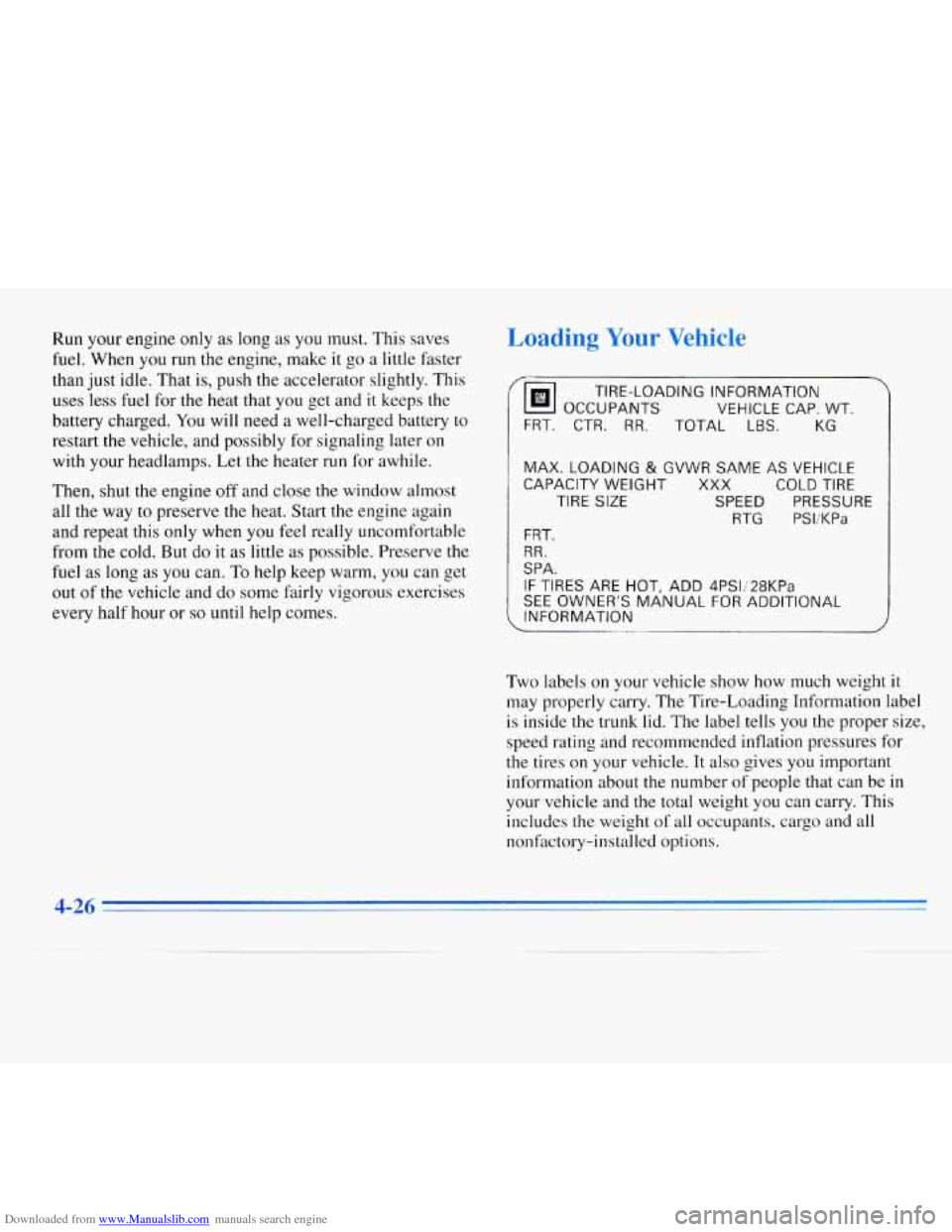
Downloaded from www.Manualslib.com manuals search engine Run your engine only as long as you must. This saves
fuel. When you run the engine, make it go a little faster
than just idle. That is, push the accelerator slightly. This
uses less fuel for the heat that you get and
it keeps the
battery charged. You will need
a well-charged battery to
restart the vehicle, and possibly for signaling later
on
with your headlamps. Let the heater run for awhile.
Then, shut the engine off and close the window almost
all the way to preserve the heat. Start the engine again
and repeat this only when you feel really uncomfortable
from the cold. But
do it as little as possible. Preserve the
fuel as long as you can. To help keep warm, you can get
out of the vehicle and do some fairly vigorous exercises
every half hour or
so until help comes.
Loading Your Vehicle
%I OCCUPANTS VEHICLE CAP. WT.
TIRE-LOADING INFORMATION
FRT. CTR. RR. TOTAL
LBS. KG
MAX. LOADING & GVWR SAME AS VEHICLE
CAPACITY WEIGHT
XXX COLD TIRE
TIRE
SIZE SPEED PRESSURE
RTG PSI/KPa
FRT.
RR.
SPA.
IF TIRES ARE HOT, ADD 4PS1;28KPa
SEE OWNER’S MANUAL FOR ADDITIONAL
INFORMATION
Two labels on your vehicle show how much weight it
may properly carry. The Tire-Loading Information label
is inside the trunk lid. The label tells you the proper size,
speed rating and recommended inflation pressures for
the tires on your vehicle. It also gives you important
information about the number
of people that can be in
your vehicle and the total weight
you can carry. This
includes the weight
of all occupants, cargo and all
nonfactory-installed options.
4-26
Page 185 of 340
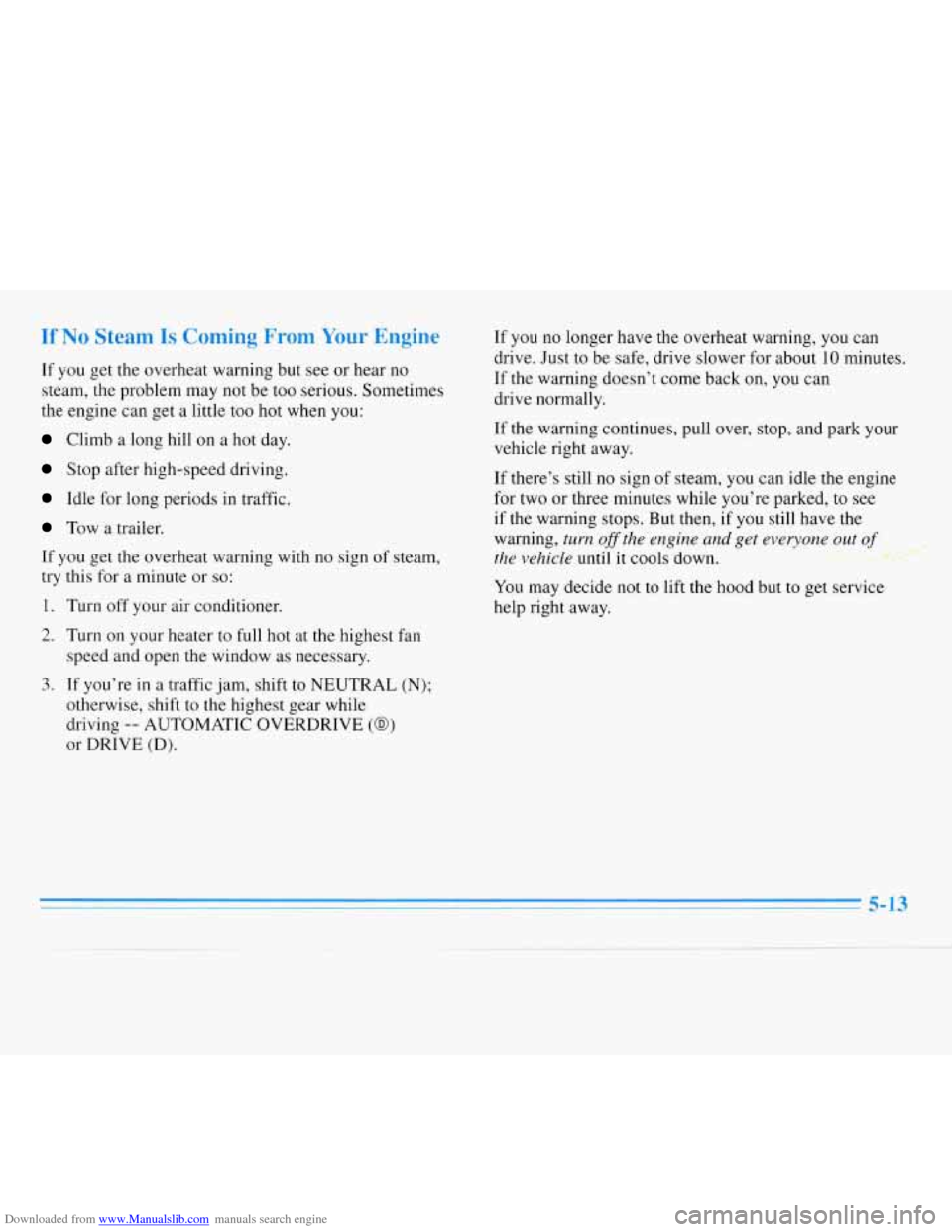
Downloaded from www.Manualslib.com manuals search engine If No Steam Is Coming From Your Engine
If you get the overheat warning but see or hear no
steam, the problem may not be too serious. Sometimes
the engine can get a
little too hot when you:
Climb a long hill on a hot day.
Stop after high-speed driving.
Idle for long periods in traffic.
Tow a trailer.
If you get the overheat warning with
no sign of steam,
try this for a minute or
so:
1. Turn off your air conditioner.
2. Turn on your heater to full hot at the highest fan
speed and open the window as necessary.
If you no longer have the overheat warning, you can
drive. Just to be safe, drive slower for about
10 minutes.
If the warning doesn’t come back on, you can
drive normally.
If the warning continues, pull over, stop, and park your
vehicle right away.
If there’s still no sign of steam, you can idle the engine
for two or three minutes while you’re parked,
to see
if the warning stops. But then, if you still have the
warning,
turn ofthe engine and get everyone out of . p~
the vehicle until it cools down. *! ?rLw&pa
You may decide not to lift the hood but to get service
help right away.
3. If you’re in a traffic jam, shift to NEUTRAL (N);
otherwise, shift to the highest gear while
driving
-- AUTOMATIC OVERDRIVE (@)
or DRIVE (D).
.
Page 187 of 340

Downloaded from www.Manualslib.com manuals search engine If the coolant inside the coolant recovery tank is boiling,
don’t do anything else
until it cools down. A CAUTION:
Heater and radiator hoses, and other engine
parts, can be very hot. Don’t touch them.
If you
do, you can be burned.
Don’t run the engine if there is a leak.
If you run
the engine, it could lose all coolant. That could
cause an engine fire, and you could be burned.
Get any leak fixed before you drive the vehicle.
The coolant level should be at or above the COLD mark.
If it isn’t, you may have a leak in the radiator hoses,
heater hoses, radiator, water
pump or somewhere else in
the cooling system.
1 NOTICE:
Engine damage from running your engine
without coolant isn’t covered
by your warranty
If there seems to be no leak, with the engine on, check to
see
if the electric engine fans are running. If the engine
is overheating, both fans should be running.
If they
aren‘t, your vehicle needs service.
Page 188 of 340
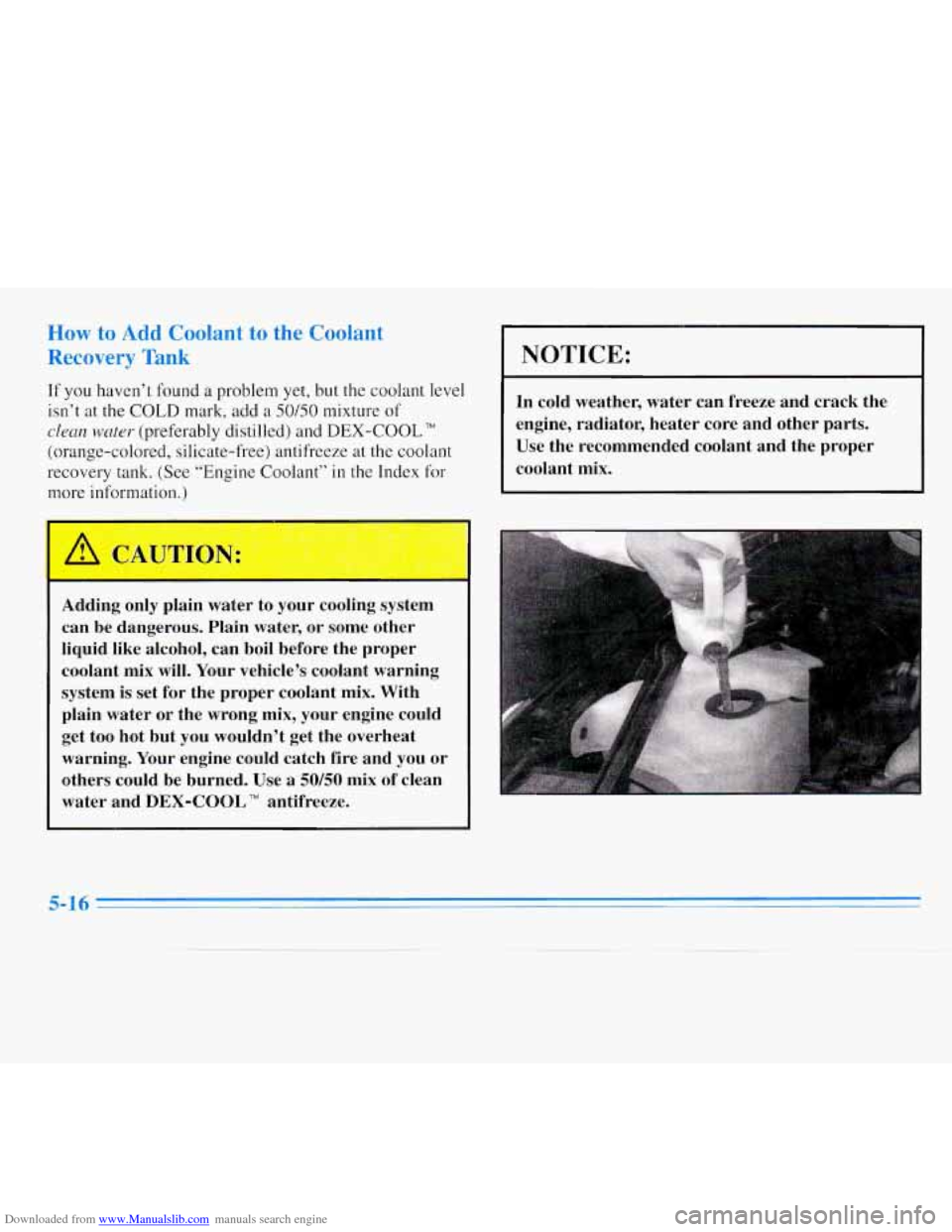
Downloaded from www.Manualslib.com manuals search engine Rea
to the - lant
rank
If you haven’t found a problem yet, but the coolant level
isn’t at
the COLD mark, add a 50/50 mixture of
clean water (preferably distilled) and DEX-COOL TM
(orange-colored, silicate-free) antifreeze at the coolant
recovery tank. (See “Engine Coolant” in the
Index for
more information.)
Adding only plain water to your cooling system
can be dangerous. Plain water, or some other
liquid like alcohol, can boil before the proper
coolant mix will. Your vehicle’s coolant warning
system is set for the proper coolant mix. With
plain water or the wrong mix, your engine could
get too hot but
you wouldn’t get the overheat
warning. Your engine could catch fire and you or
others could be burned. Use a
50/50 mix of clean
water and
DEX-COOL TM antifreeze.
1 NOTICE:
In cold weather, water can freeze and crack the
engine, radiator, heater core and other parts. Use the recommended coolant and the proper
coolant mix.
5-16